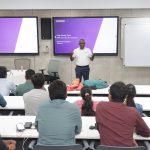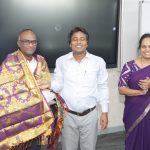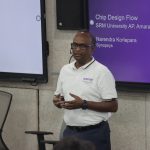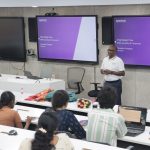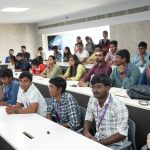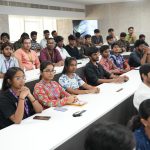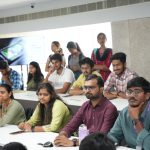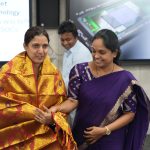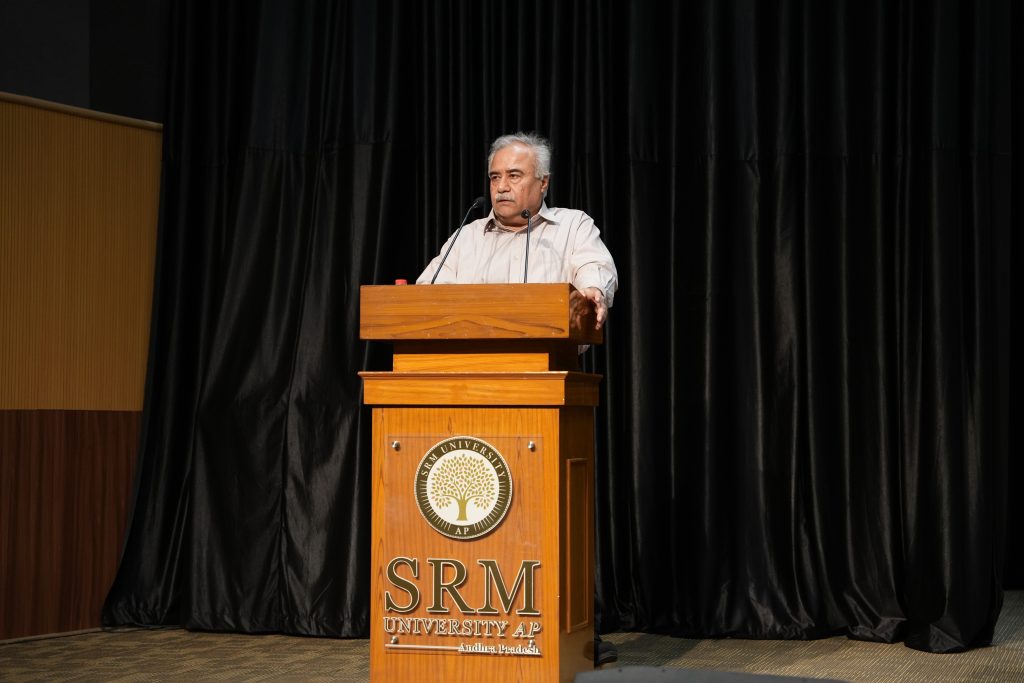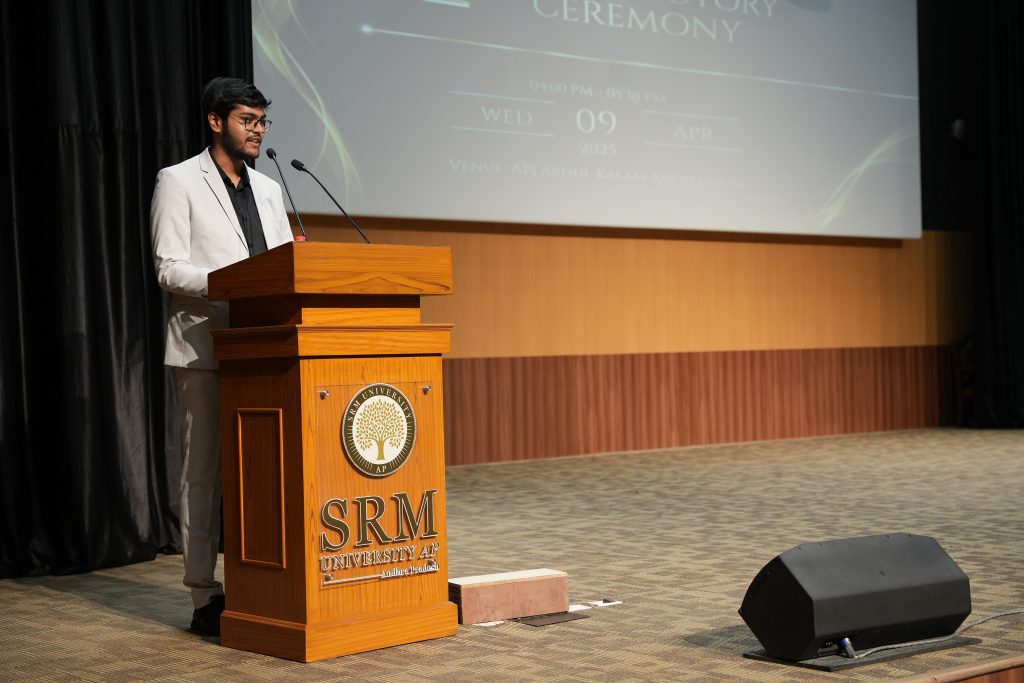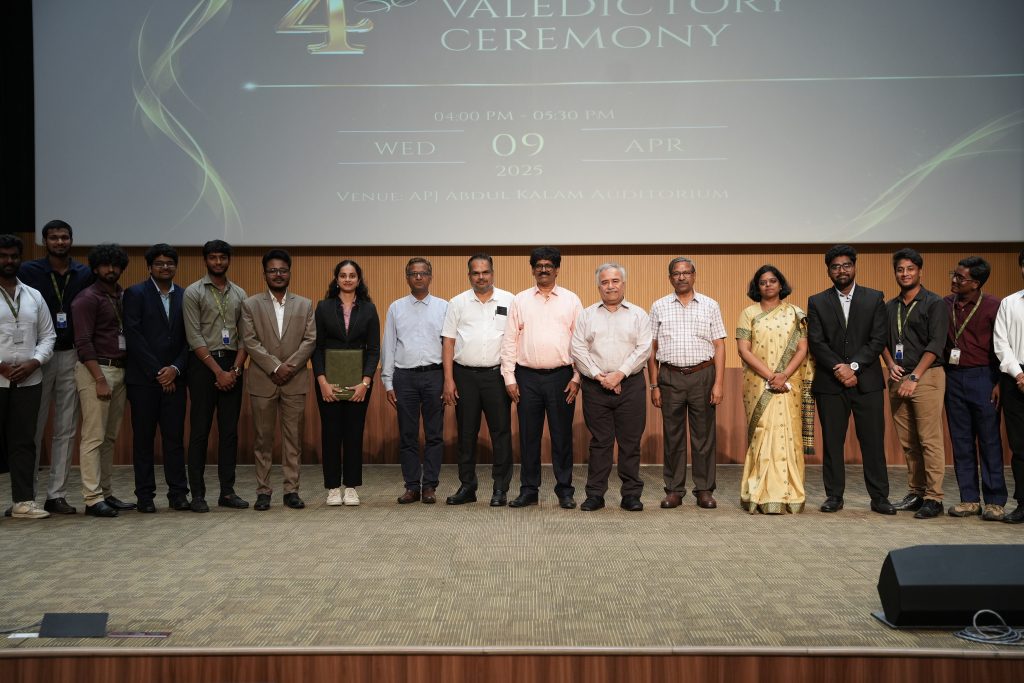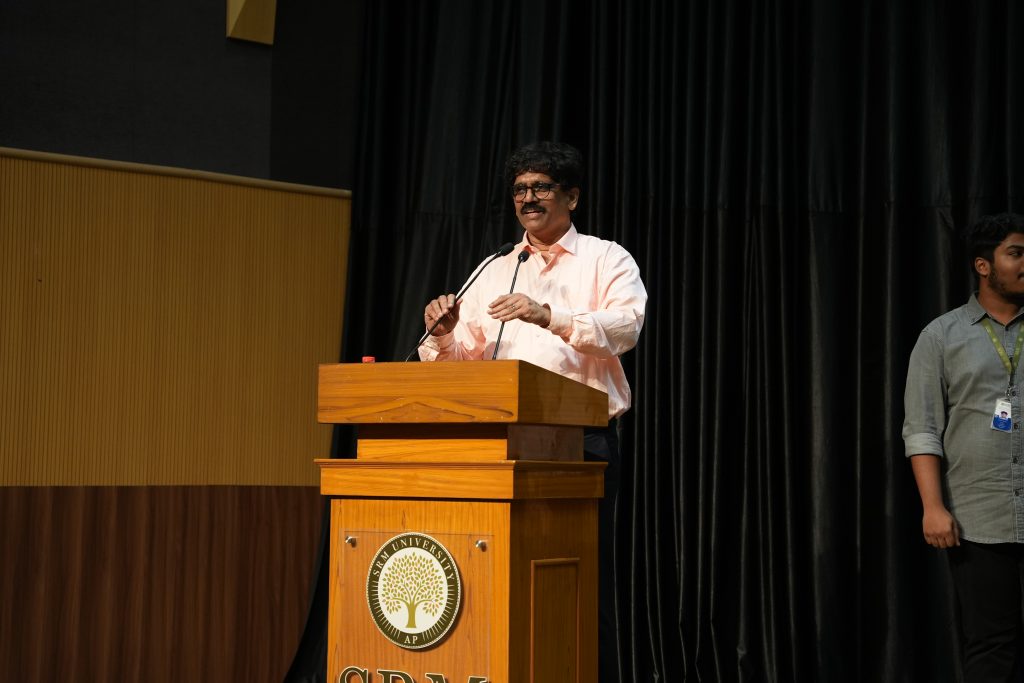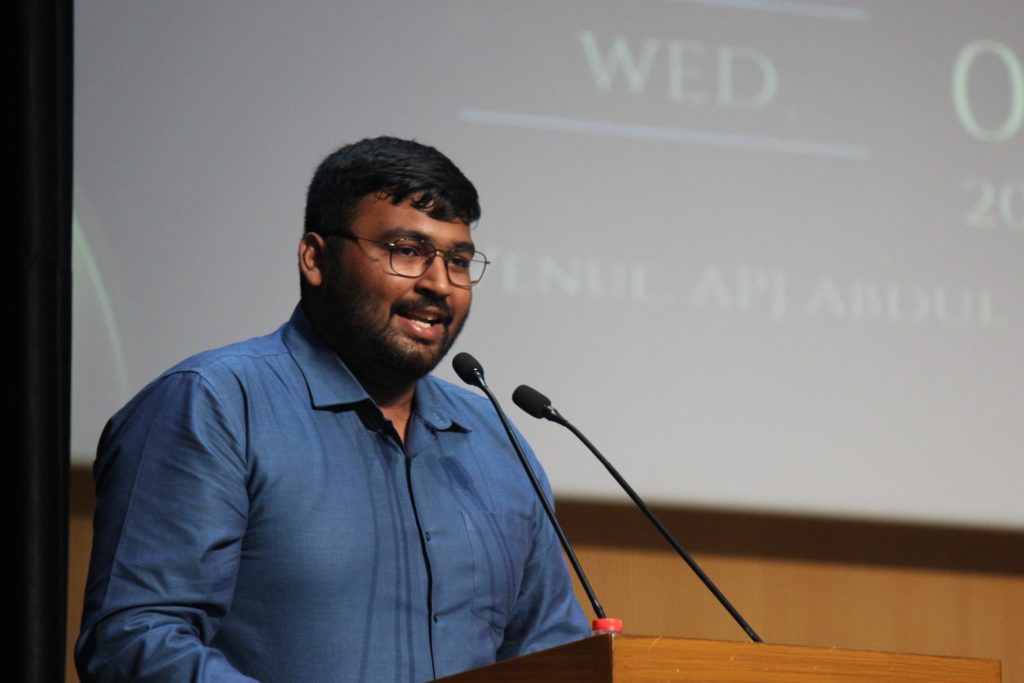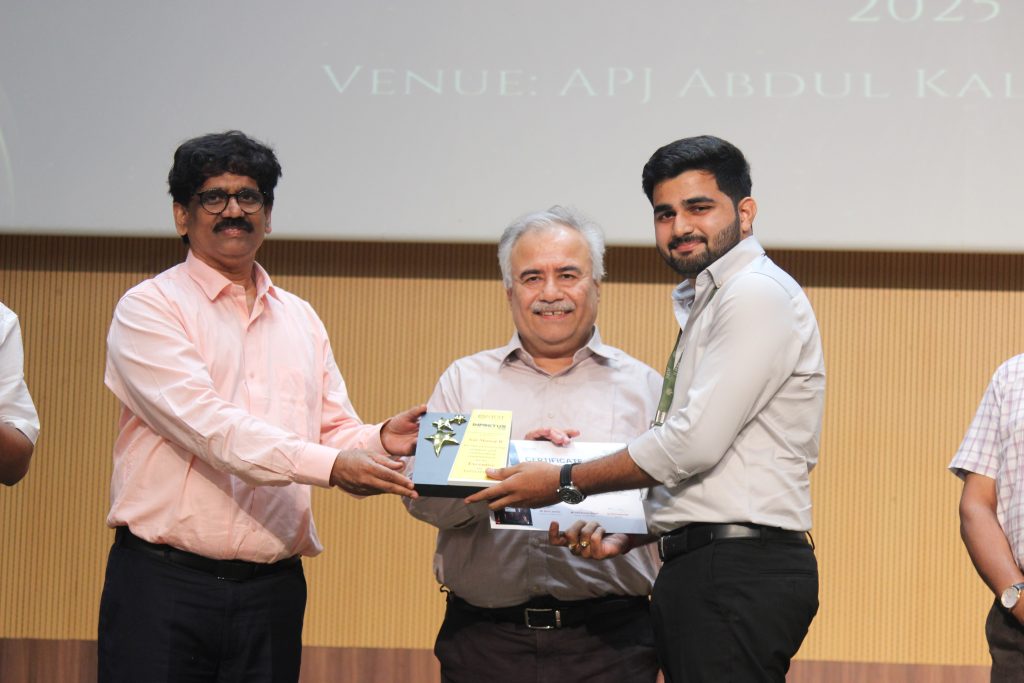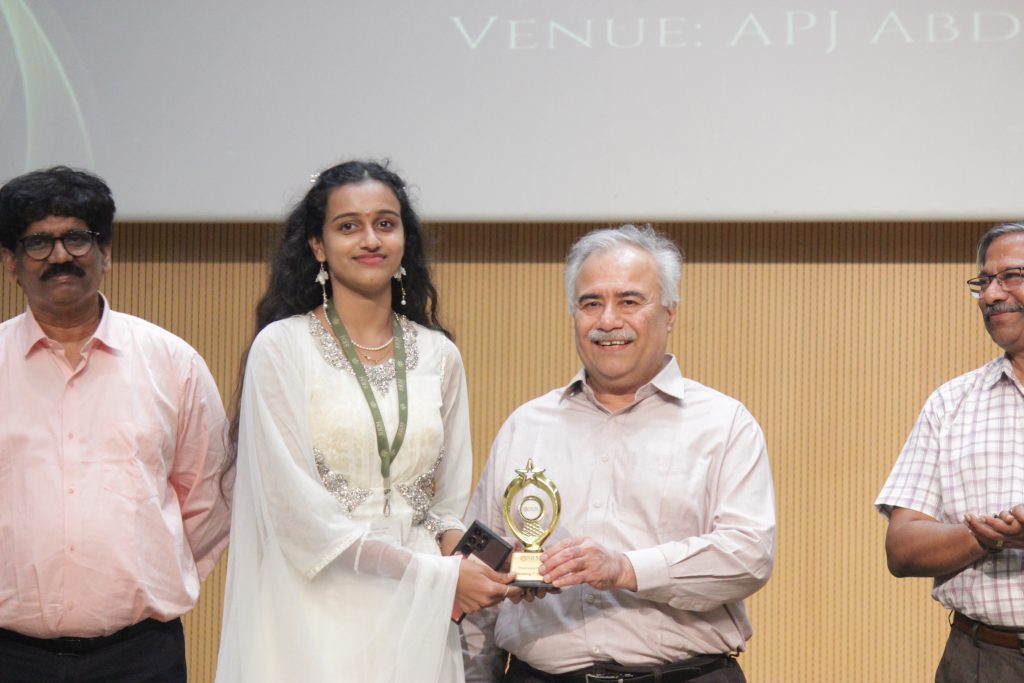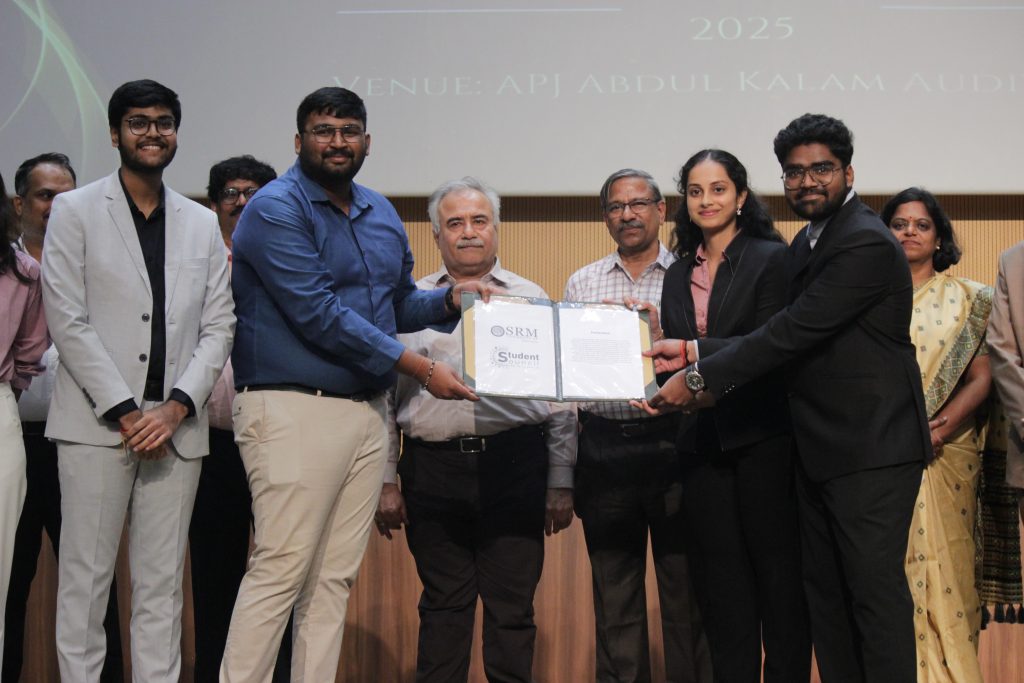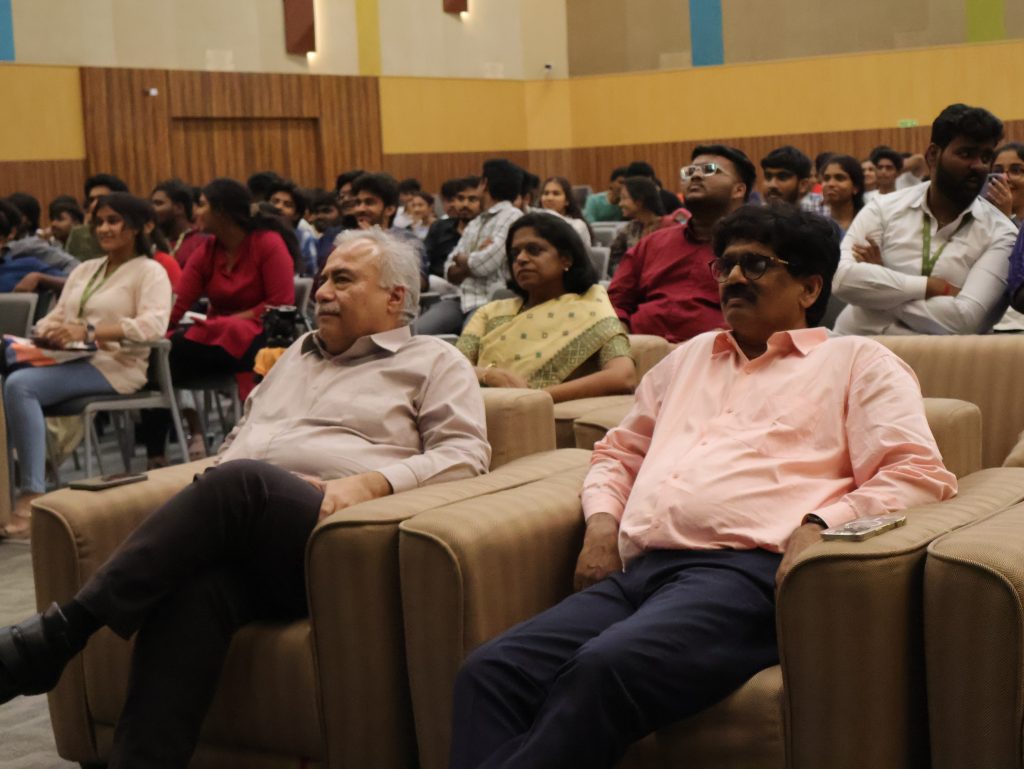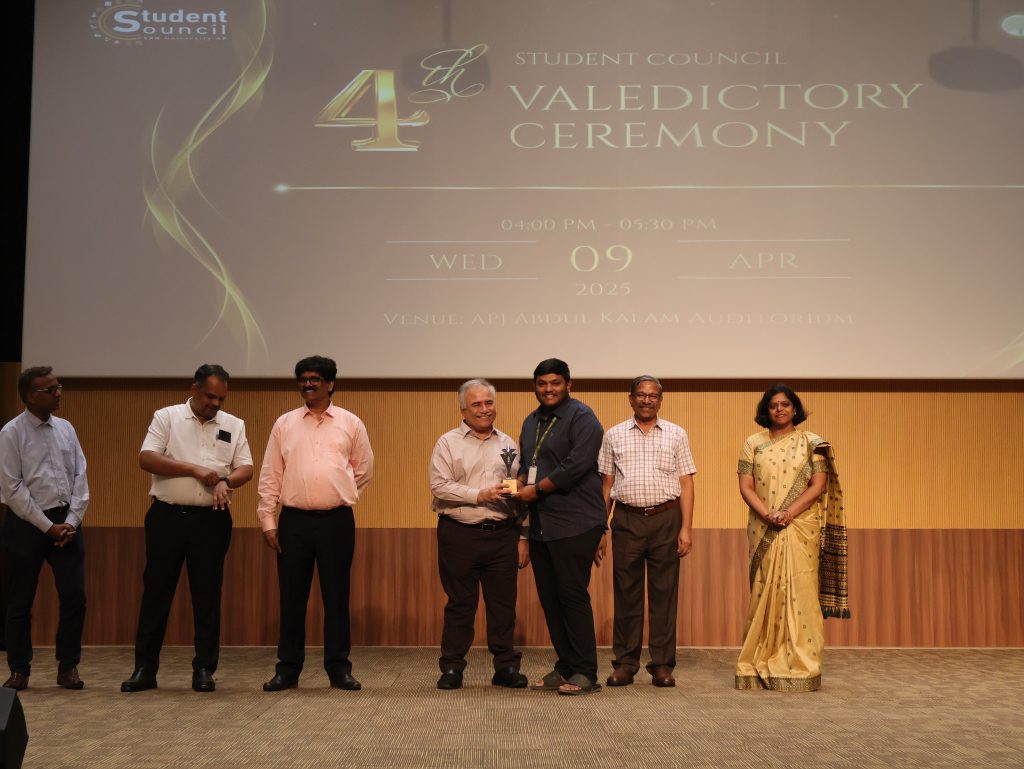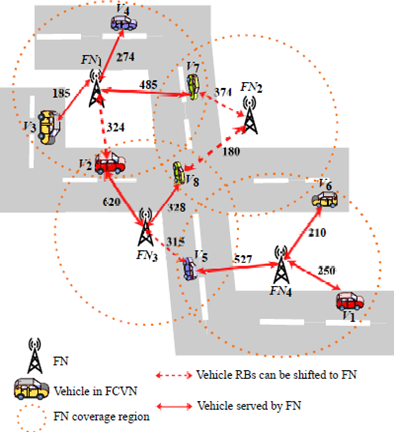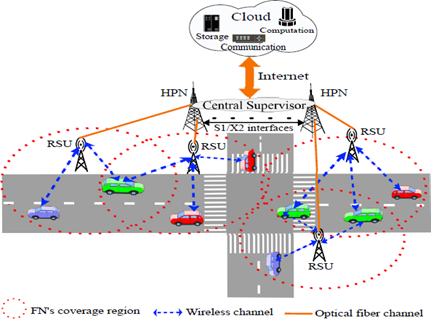- 1st Industry Colloquium on Semiconductors April 30, 2025
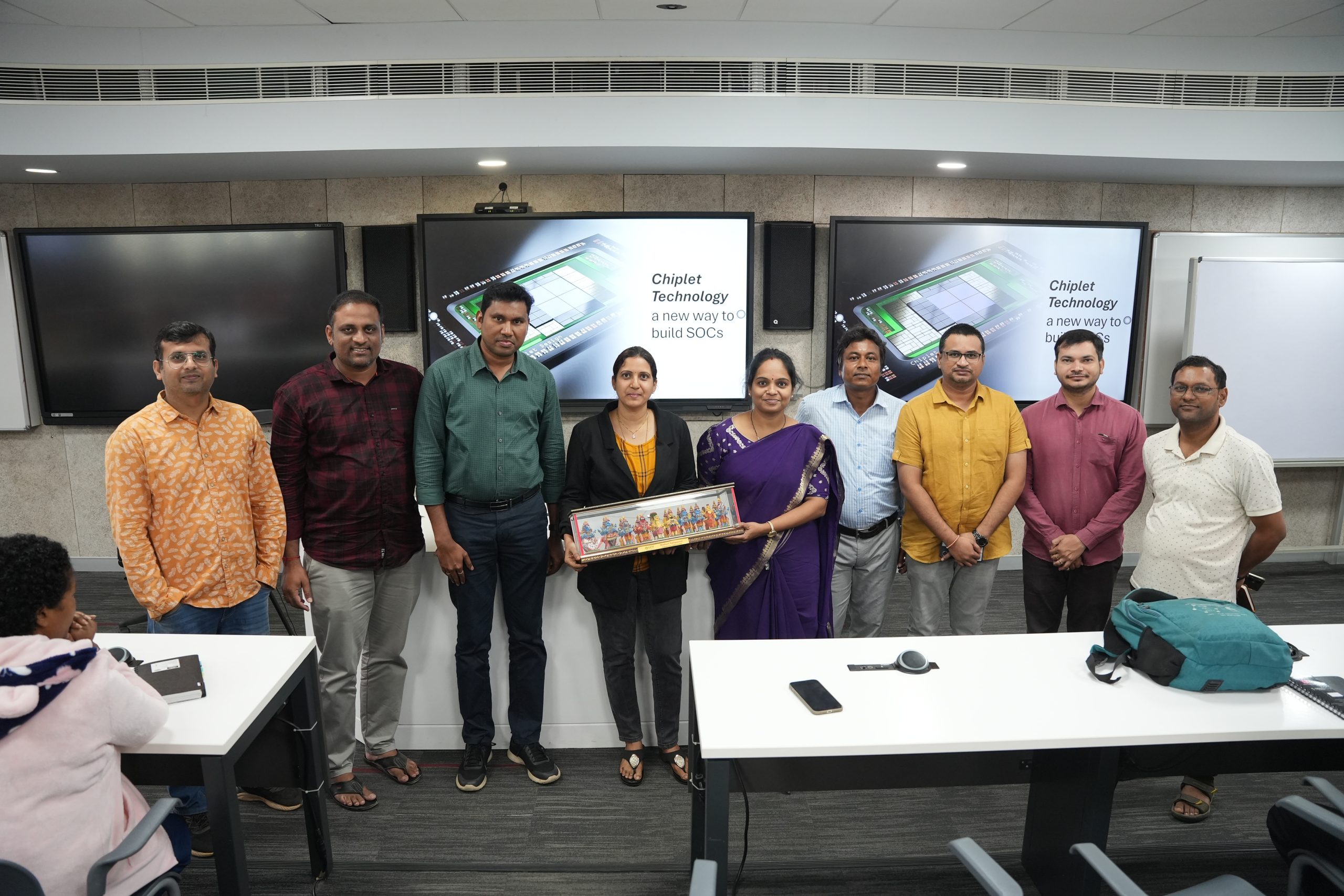 The 1st Industry Colloquium on Semiconductors, titled “Preparing Talent for Technology Leadership,” was organised by the Department of Electronics and Communications Engineering at SRM AP. This event drew a vibrant crowd of 200+ participants, including industry experts, academic professionals, researchers, and students. The colloquium showcased the transformative role of collaboration between academia and industry within the semiconductor sector.
The 1st Industry Colloquium on Semiconductors, titled “Preparing Talent for Technology Leadership,” was organised by the Department of Electronics and Communications Engineering at SRM AP. This event drew a vibrant crowd of 200+ participants, including industry experts, academic professionals, researchers, and students. The colloquium showcased the transformative role of collaboration between academia and industry within the semiconductor sector.Mrs Madhuri Nallapaneni, Group Director of Design Engineering at Cadence-Invecas Technologies, kicked off the discussions with her talk, “Chiplet Technology: A New Way to Build SoCs.” With over 20 years of experience in leading semiconductor firms like AMD and TI, she offered an engaging overview of how the evolving chiplet design paradigm has the potential to revolutionise System-on-Chip (SoC) development.
Mr Narendra Korlepara, Sr. Director & Site Leader at Synopsys Hyderabad, spoke on “Chip Design Flow from EDA Tools Perspective.” His session highlighted the vital importance of Electronic Design Automation (EDA) tools in contemporary chip development, drawing from his extensive experience in global operations.
In another notable session, Mr Venkatesh, Senior Expert at Silicon Labs University, delved into “Wireless MCU Design.” With more than 38 years in engineering, he provided a comprehensive overview of wireless microcontroller unit design and the future of wireless connectivity within embedded systems and the Internet of Things (IoT).
Dr Krishna Kanth Avalur, Founder and CTO of MOSart Labs, discussed “CMOS Automotive Power Management IC Design.” He shared insights into innovations in analog and mixed-signal design for automotive applications, stressing the importance of hardware efficiency, intellectual property development, and student upskilling.
The colloquium concluded with a strong message advocating for continued collaboration and mentorship to cultivate a skilled and future-ready workforce. The organising committee, led by Dr K A Sunitha and Dr Pradyut Kumar Sanki from the Department of Electronics and Communication Engineering at SRM University-AP, played a vital role in making this event a success.
Continue reading → - Celebrating Leadership and Transition April 30, 2025
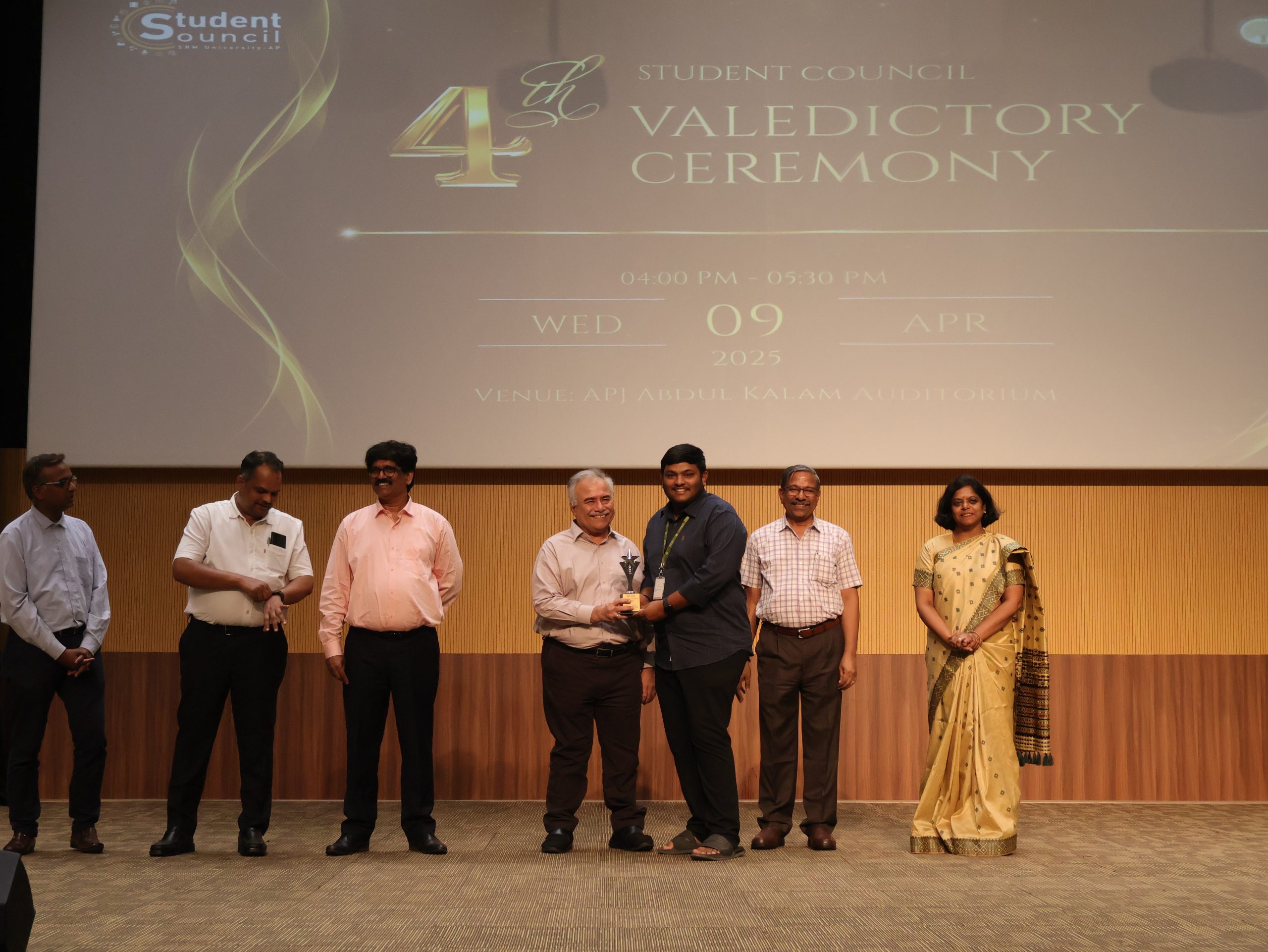 The 4th Valedictory Ceremony for the Student Council at SRM University-AP was held on April 9, 2025. This event honored the significant contributions of the outgoing Student Council for the academic year 2024-2025 and marked the formal induction of the newly appointed Student Council for the year 2025-2026.
The 4th Valedictory Ceremony for the Student Council at SRM University-AP was held on April 9, 2025. This event honored the significant contributions of the outgoing Student Council for the academic year 2024-2025 and marked the formal induction of the newly appointed Student Council for the year 2025-2026.The ceremony commenced with an inspiring address by Mr Ramesh Vadi, Director of Student Affairs, and highlights of the milestones achieved by the student community over the year. Following this, Mr BVS Laxman, President of the Student Council 2024-2025, shared his enriching journey in the council. He spoke about the collaborative efforts, challenges, and learning experiences that shaped his tenure. The event further featured addresses by Ms Nivedha Sriram, Vice President, Mr Ankith Reddy, General Secretary, and Mr Rishabh Ranjan – Treasurer. Each of them reflected on their roles and cherished memories while expressing gratitude for the opportunity to serve the student community.
A heartwarming video presentation captured the Moments of the Year, showcasing the highlights, achievements, and unforgettable experiences that brought students together throughout the year. The ceremony proceeded with the Felicitation of Infinitus Executives, Heads, and Co-Heads, recognizing their relentless efforts in making SRM University-AP’s largest fest a resounding success. This was followed by the Felicitation of the Student Council Members, appreciating their dedication and commitment throughout their term.
A much-awaited segment of the event was the Announcement of the New Council Wing Heads for 2025-2026, paving the way for fresh leadership and innovation. In a significant announcement, Vice-Chancellor Prof. Manoj K Arora introduced the new Core Council Members for the academic year 2025-2026. The new core team comprises Nivedha Sriram as the President, Nithenn Redhi as the newly introduced Working President, Rishabh Ranjan as the Vice President, Sairam Koushal as the General Secretary, and Sri Nandan Talluri as the Treasurer.
The event concluded with the symbolic Handing Over Ceremony, where the outgoing council officially passed on their responsibilities to the new council, marking a new chapter of leadership, service, and student engagement at SRM University-AP.
Continue reading → - Insights on Leptogenesis and Dark Matter Production April 30, 2025
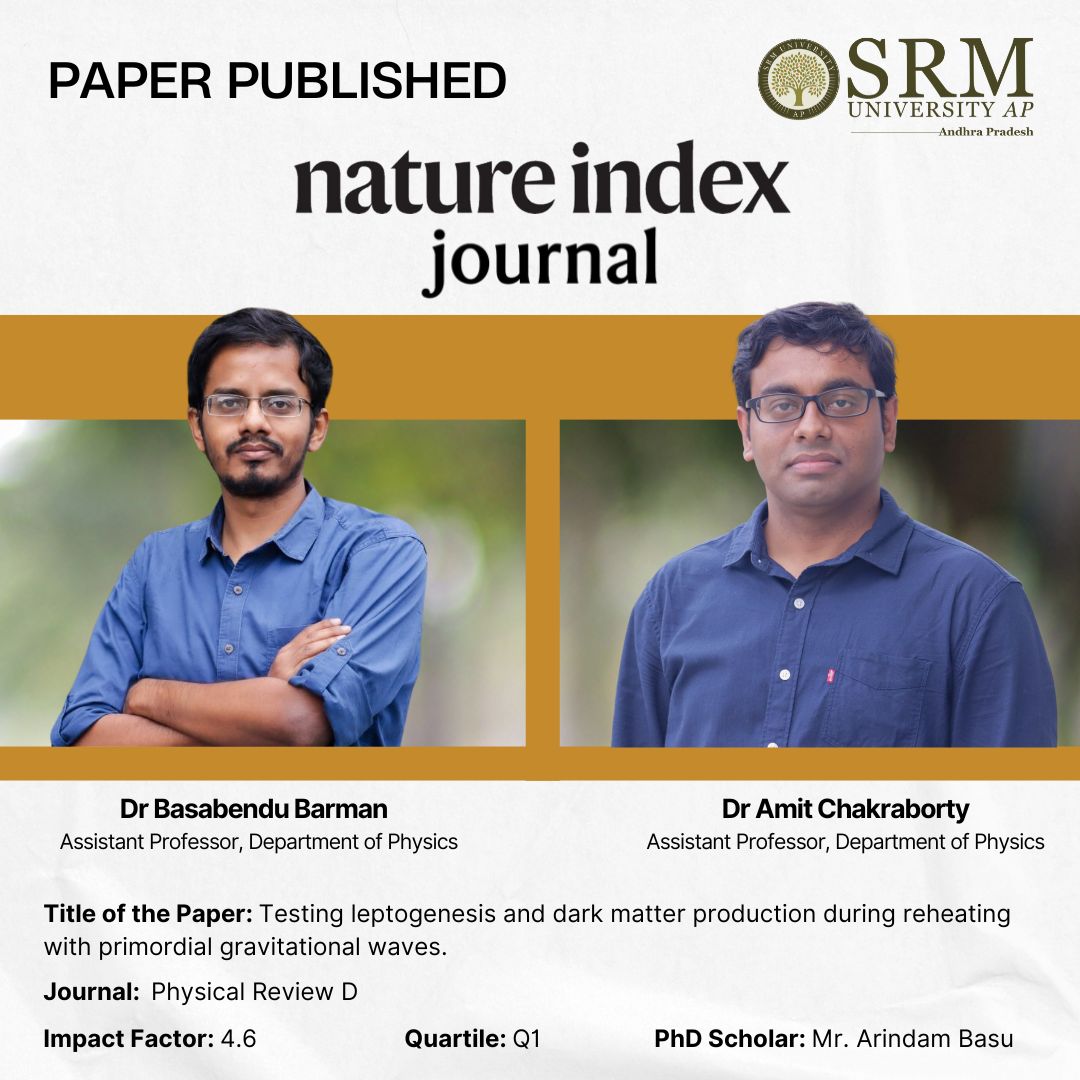 Dr Basabendu, Dr Amit Chakraborty, and Mr Arindam Basu from the Department of Physics at SRM University-AP jointly authored the study titled, “Testing leptogenesis and dark matter production during reheating with primordial gravitational waves” which was published in Physical Review D (Nature Index). The research looks into different monomial potentials and various decay processes of the inflaton field, providing important insights into fundamental cosmic events.
Dr Basabendu, Dr Amit Chakraborty, and Mr Arindam Basu from the Department of Physics at SRM University-AP jointly authored the study titled, “Testing leptogenesis and dark matter production during reheating with primordial gravitational waves” which was published in Physical Review D (Nature Index). The research looks into different monomial potentials and various decay processes of the inflaton field, providing important insights into fundamental cosmic events.Abstract:
We study the generation of baryon asymmetry as well as dark matter (DM) in an extended reheating period after the end of slow-roll inflation. Within the regime of perturbative reheating, we consider different monomial potential of the inflaton field during reheating era. The inflaton condensate reheats the Universe by decaying into the Standard Model (SM) bath either via fermionic or bosonic decay modes. Assuming the leptogenesis route to baryogenesis in a canonical seesaw framework with three right handed neutrinos (RHN), we consider both the radiation bath and perturbative inflaton decay to produce such RHNs during the period of reheating when the maximum temperature of the SM bath is well above the reheating temperature. The DM, assumed to be a SM gauge singlet field, also gets produced from the bath during the reheating period via UV freeze-in. In addition to obtaining different parameter space for such nonthermal leptogenesis and DM for both bosonic and fermionic reheating modes and the type of monomial potential, we discuss the possibility of probing such scenarios via spectral shape of primordial gravitational waves.
Practical Implementations & Social Impact:
Imagine the early universe as a giant, chaotic fireball after the Big Bang. But before things settled down into the stars and galaxies we see today, the universe went through a phase called inflation—a rapid expansion driven by a field called the inflaton. Once inflation ended, the inflation’s energy had to somehow convert into all the particles that make up our universe. This process is called reheating. In this study, we explore what happens if reheating takes longer than usual, extending well beyond what’s typically assumed. We look at different ways the inflaton could decay—either into particles like fermions (similar to electrons) or bosons (like the Higgs boson)—and how this affects the formation of two big cosmic mysteries: the matter-antimatter asymmetry (baryon asymmetry) and dark matter. We analyse how different inflaton decay mechanisms and different types of inflaton energy landscapes (represented by mathematical potentials) influence these processes. Beyond just predicting what parameters could make this scenario work, we also suggest a possible way to test it: by looking at primordial gravitational waves, ripples in spacetime left over from the early universe. Their specific features might reveal hints about how reheating played out, offering a new way to probe the origins of matter and dark matter.
This study is not just about abstract physics—it’s about our origins. Understanding how matter and dark matter formed in the early universe connects directly to our existence and could shape future discoveries in physics, technology, and space exploration. Whether it’s through deep-space telescopes, gravitational wave detectors, the quest to understand the first moments of the universe is one that could transform the way we see our place in the cosmos.
Collaborations:
This work has been done in collaboration with Dr Amit Chakraborty and Mr Arindam Basu from the Department of Physics, SRM University-AP
Future Plans:
A closer look at early universe dynamics by performing more involved simulations.
Connection between particle physics models and early Universe cosmology.
Complementary searches from different experiments in unravelling new physics beyond the Standard Model. Searching for new physics at the energy and intensity frontier.Link: https://journals.aps.org/prd/abstract/10.1103/PhysRevD.111.055016
Continue reading → - Research on High-Performance Metal-Free Catalyst April 30, 2025
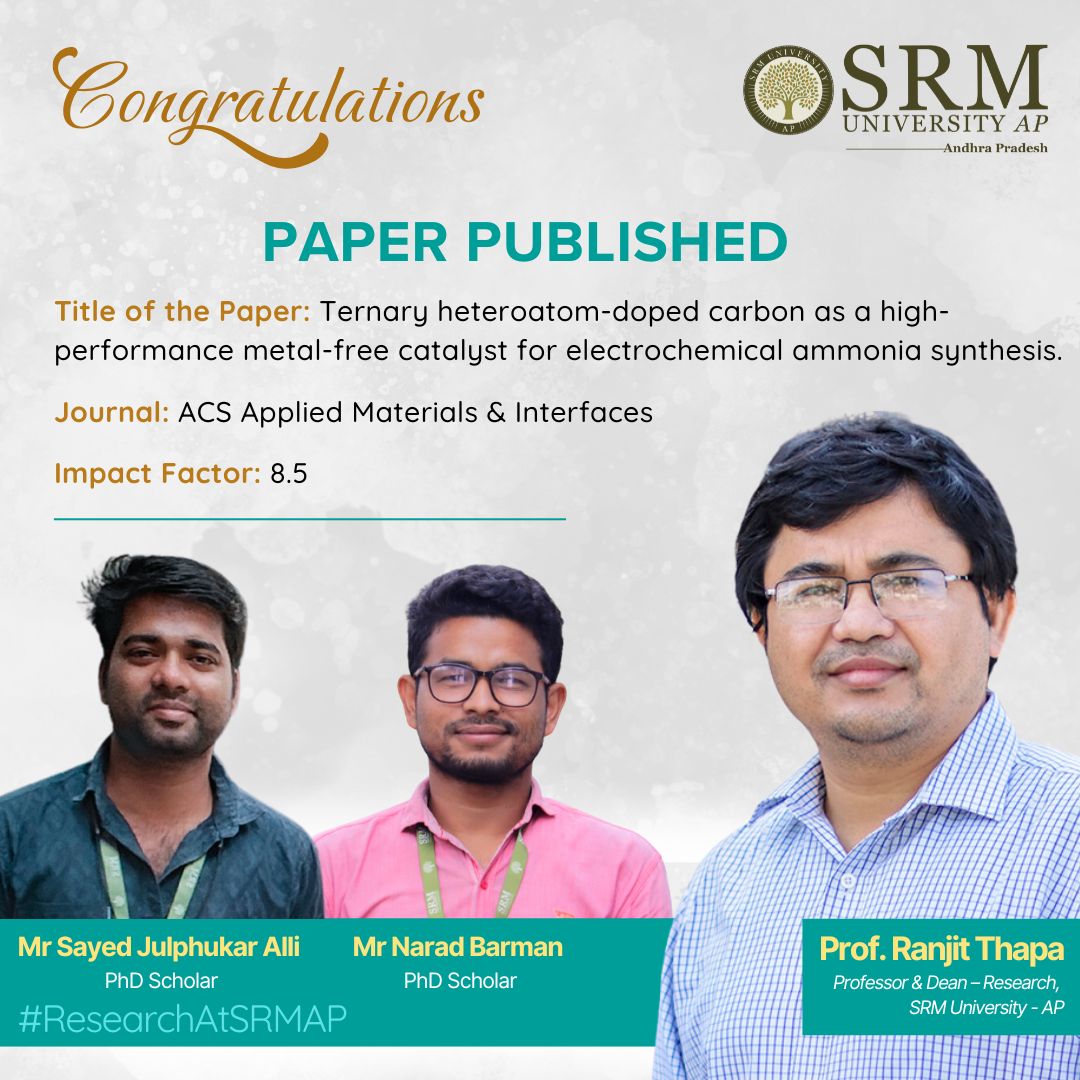 In the paper titled “Ternary Heteroatom-doped Carbon as a High-performance Metal-free Catalyst for Electrochemical Ammonia Synthesis.” by Prof. Ranjit Thapa and his research Scholars, a novel approach to enhance nitrogen reduction reactions (NRR) is explored. This research, published in ACS Applied Materials & Interfaces, investigates the potential of nitrogen-doped carbon materials further enhanced by the incorporation of boron and fluorine heteroatoms. The study reveals significant advancements in electrocatalytic performance, emphasising the importance of efficient and sustainable ammonia production.
In the paper titled “Ternary Heteroatom-doped Carbon as a High-performance Metal-free Catalyst for Electrochemical Ammonia Synthesis.” by Prof. Ranjit Thapa and his research Scholars, a novel approach to enhance nitrogen reduction reactions (NRR) is explored. This research, published in ACS Applied Materials & Interfaces, investigates the potential of nitrogen-doped carbon materials further enhanced by the incorporation of boron and fluorine heteroatoms. The study reveals significant advancements in electrocatalytic performance, emphasising the importance of efficient and sustainable ammonia production.Abstract :
Electrochemical nitrogen reduction reaction (NRR) has garnered much attention, but the major challenge remains with efficient electrocatalysts. Metal-free carbonaceous materials, doped with heteroatoms and structural defects, present a promising alternative to metal-based catalysts. This study introduces a novel strategic stepwise synthesis strategy of defective nitrogen-doped carbon material, further doped with secondary heteroatoms boron and fluorine (FBDG). These secondary atoms in combination create additional active sites for nitrogen adsorption, activation and suppress the hydrogen evolution reaction (HER). The synergistic effect of three heteroatoms and induced defects in the catalyst enhances electron-donor behaviour, improving π bonding within the carbon framework and facilitating the electron transfer processes during NRR, resulting in a significantly high Faradaic efficiency of 38.1 % in the case of metal-free electrocatalysts. The theoretical calculation reveals that FBDG possesses sufficient charge density to reduce nitrogen at a low overpotential following an alternating free energy pathway. The reaction intermediates are thereby identified by in situ ATR-FTIR studies. For rapid screening of ammonia, we used a rotating ring disk system (RRDE) and did a kinetic study. The high efficiency, stability, and cost-effectiveness of FBDG position it as a strong contender for sustainable ammonia production and open up the way for future advancements in NRR.Practical implementation:
The practical implementation of your research or the social implications associated with it.The FBDG catalyst achieved a remarkable Faradaic efficiency of 38.1 %. Theoretical studies confirmed that FBDG has a low overpotential, thereby increasing its appropriateness for NRR. The incorporation of fluorine and boron through co-doping in N-doped defective material enhances the N2 absorption energy, and from the charge density difference, we showed improved electron delivery from the host surface to the intermediate, which is essential for breaking the strong triple bond in N2 molecules, enhancing NRR. This work not only introduces a novel catalyst design strategy but also provides deep insights into the synergistic effects of heteroatom doping and defect engineering, paving the way for more efficient and sustainable ammonia production.Collaborations
Dr Ramendra Sunder Dey, Assistant Professor (Scientist-D), INSA Associates, Institute of Nano Science and Technology, Mohali
Continue reading → - Research Paper on Efficient Resource Orchestration Algorithm April 30, 2025
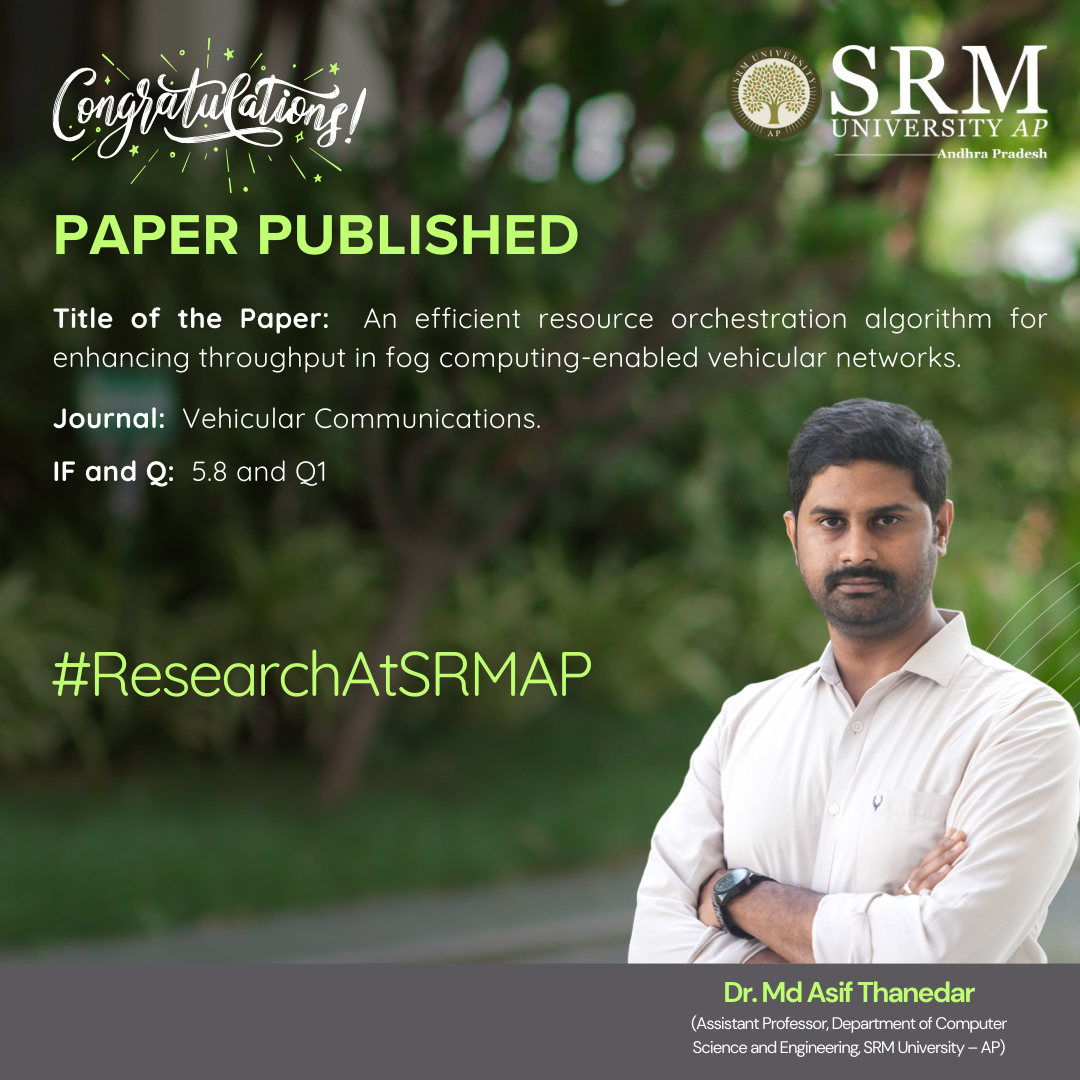 Dr Asif Thanedar, Assitant Professor at the Department of Computer Science and Engineering in research titled “An Efficient Resource Orchestration Algorithm for Enhancing Throughput in Fog Computing-enabled Vehicular Networks,” discusses issues faced by fog nodes (FNs) when serving connected vehicles during busy times. The research introduces an Efficient Resource Orchestration (ERO) algorithm designed to improve network performance by optimising resource use within the limits of FNs. The study aims to make a valuable contribution to the fields of vehicular fog computing and resource management.
Dr Asif Thanedar, Assitant Professor at the Department of Computer Science and Engineering in research titled “An Efficient Resource Orchestration Algorithm for Enhancing Throughput in Fog Computing-enabled Vehicular Networks,” discusses issues faced by fog nodes (FNs) when serving connected vehicles during busy times. The research introduces an Efficient Resource Orchestration (ERO) algorithm designed to improve network performance by optimising resource use within the limits of FNs. The study aims to make a valuable contribution to the fields of vehicular fog computing and resource management.Abstract :
The intelligent vehicles are connected to the roadside infrastructure, such as high power nodes (HPNs) and roadside units (RSUs), also called fog nodes (FNs), for obtaining on-demand services. These FNs possess finite resources and can provide services to limited vehicles. However, when vehicles reach the network spike in demand, the FNs become impuissant in furnishing services in the existing solutions. As a result, there is a significant reduction in the network throughput. Therefore, we propose an efficient resource orchestration (ERO) algorithm to maximize the throughput by reducing the allocated resource blocks (RBs) of FNs.
Explanation in layperson’s terms:
The throughput is maximized by migrating allotted RBs of vehicles in non-restricted coverage regions such that the allotted RBs of these vehicles are minimized among pairs of FNs.
We formulated the RBs migration problem in FCVNs to an integer linear programming (ILP) by scrutinizing the variables influencing the network throughput and FNs resource constraints.
We propose an ERO algorithm, a polynomial time algorithm, which constructs the minimum priority queue for optimal RBs migration between pairs of FNs to augment the network’s throughput. The ERO algorithm synchronizes the RBs allocation for offloading upstream services such that throughput is maximized by partitioning the coverage of FNs into restricted and non-restricted coverage regions.Practical implementation:
For practical implementation we consider the FNs are equipped with large batteries and deployed across the highway segments of remote areas (i.e., forests or hill terrain) with no consistent power supply. In this context, we present an efficient resource orchestration (ERO) algorithm for harmonizing RB allocation and offloading upstream services among FNs to maximize the network throughput during battery depletion.
Collaborations:
Dr Sanjaya Kumar Panda, Assistant Professor, Dept. of CSE, National Institute of Technology Warangal.
Future Research Plans:
Resource Provisioning in Fog environment.
Energy Efficiency in vehicular fog computing (VFC).
Multi-objective optimization in fog computing.
Continue reading →


